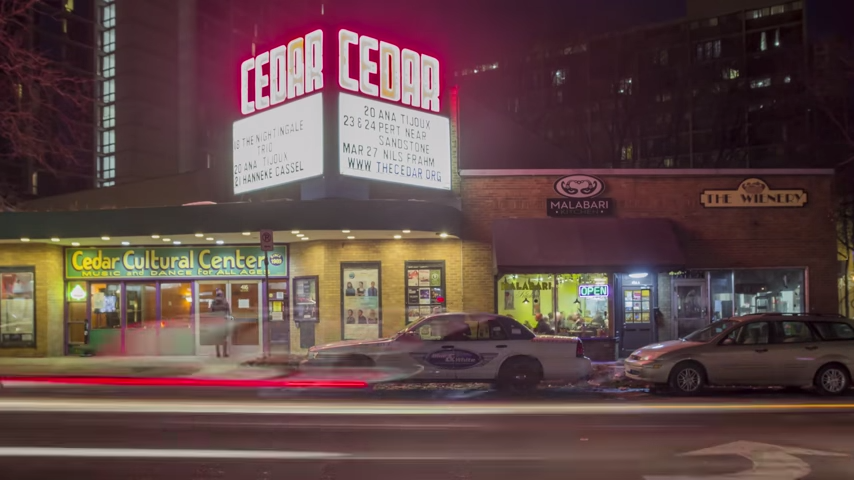
MISSION & HISTORY
Our Mission
The Cedar’s mission is to promote intercultural appreciation and understanding through the presentation of global music and dance. The Cedar is committed to artistic excellence and integrity, diversity of programming, support for emerging artists, and community outreach.
About The Cedar
Located in the heart of Cedar Riverside, one of the most prolific neighborhoods for live music in Minneapolis, and the home to the largest Somali diaspora in the U.S., The Cedar plays a key role in maintaining the vibrancy and diversity of the Twin Cities’ arts scene.
Through 200+ shows a year and programs such as Midnimo, the Cedar Commissions, and the Global Roots Festival The Cedar continues to fulfill its mission of promoting intercultural appreciation through global music.
From world legends to up-and-coming new bands, The Cedar presents unique voices from around the globe with programming that spans global roots, folk, indie, experimental, bluegrass, Americana and blues genres, and includes as artist residencies, educational programs, workshops, films, dances, comedy, spoken word and community events.
The Cedar's hall can be configured for seated concerts (400 capacity) as well as standing room concerts (645 capacity) and provides high-quality sound in an intimate concert environment, never putting the audience member more than 30 feet away from the stage.
“The Cedar is regarded as one of the best venues in the country to be able to see and hear an artist as though you were in their living room.”
— Minnesota Public Radio
History
The only all-ages venue of its kind in the Midwest, The Cedar was established in 1989 and operates in a building that was constructed as a movie theater.
Oct 28, 1948: The future home of The Cedar Cultural Center opens as a movie theater showing “Big City” directed by Norman Taurog.
1969: Minnesota Dance Theatre signs a lease for The Cedar’s building, then known as the Cedar Village Theatre. Arts and music become a part of the building’s DNA. Leo Kottke often plays in the space at midnight, and free “People’s Concerts” are offered to the community.
1975: The venue reopens as the Cedar Theatre, screening quality movies and hosting occasional live performances.
September 16, 1989: The Cedar Cultural Center opens as a central venue for live music on the West Bank at a time when the neighborhood is in transition and seeking new economic development. Social dance, international sounds, folk artists and Celtic roots music thrive in the new Cedar space.
1990s - 2000s: The Cedar grows as an important venue for national and global music, presenting even more national and international musicians on its stage, such as Doc Watson, Ani DiFranco, Väsen,
1999: The Cedar launches its three-day Nordic Roots Festival, a Cedar favorite that would continue for a decade. Audiences flock to see exciting new artists from Scandinavia taking traditional music in contemporary directions.
2009: Building on the vision of the Nordic Roots Festival, The Cedar partners with other Midwest presenters to launch The Global Roots Festival, a free series featuring innovative new global artists touring through the US each September.
2011: Seeing the need for more opportunities for Minnesota artists, The Cedar introduces The Cedar Commissions. The first class of artists includes Maria Isa, Dessa, Aby Wolf, Adam Levy, and more.
2013: In response to local demand, The Cedar opens its doors to the first of six annual 28-hour Drone Not Drones concerts, a benefit for Doctors Without Borders that unites 60+ local and national musicians annually, such as Alan Sparhawk of Low.
2014: Embracing the West Bank’s Somali community, The Cedar introduces Midnimo, a groundbreaking program that aims to increase understanding and awareness of Muslim and Somali cultures and identities through music. Reuniting Dur Dur Band, Mogadishu’s legendary disco band, is one of Midnimo’s first successes.
2018: The Cedar kicks off its 30th Season at the 10th annual Global Roots Festival with a celebratory birthday concert featuring Aar Maanta (UK/Somalia) and Hoven Droven (Sweden), a perfect pairing that speaks to the evolving story of the West Bank neighborhood and The Cedar’s “traditionally nontraditional” history!
2019: Embarking on an exciting new chapter, The Cedar engages six artists of color as the first cohort of The Artist Collective, a move from demonstrating representation and diversity to actively practicing inclusion and equity as an organization.
All the people who play folk music, they know that folk music is global. This [West Bank] community is a very beautiful community. There’s a mixing of cultures and The Cedar is at the center of it”
— Jens Comén, Hoven Droven

